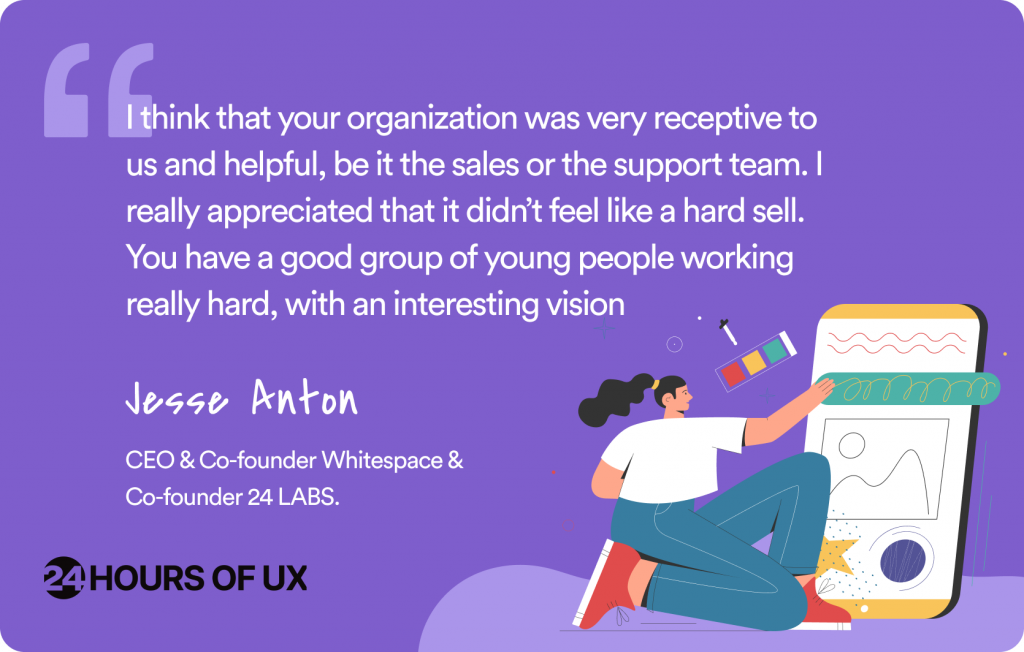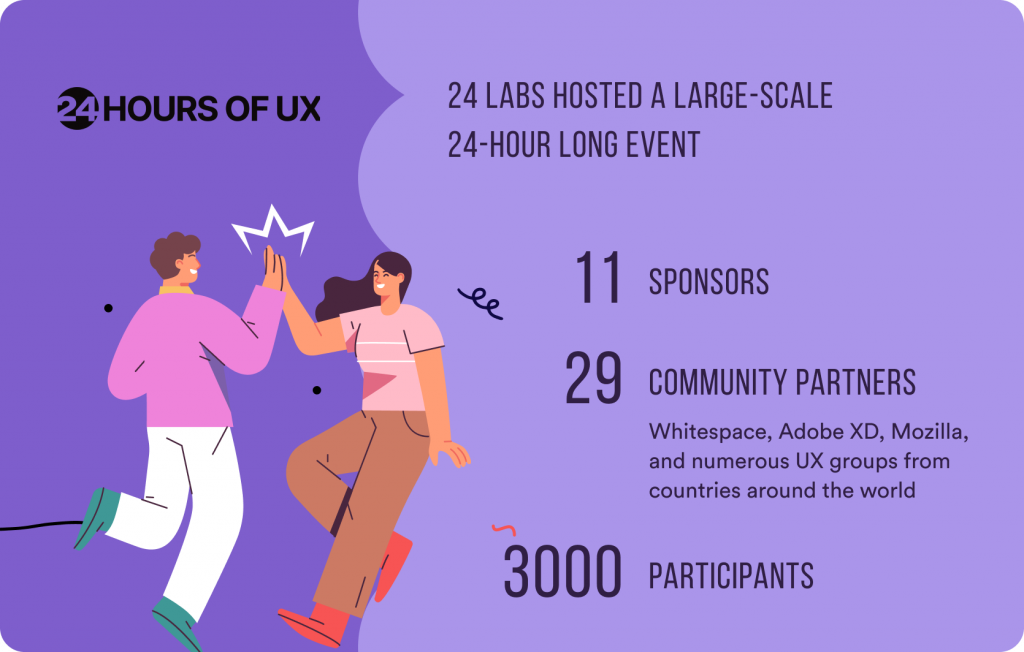Executive Summary
24 LABS is a non-profit organization and a worldwide community initiative around User Experience (UX). It unites the local communities working locally in UX at the global level. They are involved in UX research, interaction design, service design, user experience consulting, usability testing, data visualization, and software development.
Jesse Anton and Peter Horvath, Co-Founders of 24 Labs shared their journey; “We have been running in-person events for the local community in Geneva for years. We had 40-45 events, with an audience of 50 to 100 people for each event.
We started as a local in-person event series, but when the pandemic hit, we reached out to other people worldwide with similar communities and went global and virtual: in 2020 we started 24 Hours of UX, a non-stop, full-day event. Eventually, we moved to Airmeet with 24 Hours of UX in 2021. We exist here to help educate and make connections between people.”
To this, Peter went on to add, “We have a core team globally spread across all the continents, Idyawati from Asia, Estefania from South America, Amy and Keith from the US, Hans from Australia, Njiiri from Africa, Ahmad from the Middle East and Johannes from Europe. Today, user experience design knowledge-sharing is more focused on the US and the developed world. Through knowledge sharing and education, we want to show how it’s done all over the world, bringing in a local flavor at the same time.”
The community hosted24 Hours of UX on Airmeet in June. As Peter Horvath, Experience and Service Design Lead mentioned:
“24 Hours of UX is a 24-hour non-stop event. We feature different speakers from around the world. Instead of approaching the speakers directly, we reached out to local communities that were also battling the challenges of COVID and were not able to do in-person events.
We asked them to do the event together on the platform to discuss the state of UX in their regional country or city. It was these local groups that proposed the speakers, based on their knowledge of the local scene.”
The event had various keynotes, presentations, and workshops where people made new connections and interacted with each other. Furthermore, it had 11 sponsors and 29 community partners, including Whitespace, Adobe XD, Mozilla, UXTesting, and numerous UX groups from countries around the world.”
Jesse and Peter explain how they leveraged Airmeet’s features to host their 24-hour long event on a big scale.

Challenges (and Solutions)
Challenge 1: Hosting an industry-wide virtual conference-style event
While talking about their search for an innovative virtual platform, Jesse explained, “There were so many platforms available when we considered our second event. We looked at how the industry had innovated and how many other players there were in the marketplace.
Then we evaluated as many platforms as we could find. Most of the platforms we saw were really geared towards being corporate-type event management platforms with corporate-type pricing. These all felt corporate in their approach as well, with little attention to the customer itself – we were looking for a real connection.
In terms of functionality, we needed something as close to a conference-style as possible. We wanted the capability to host an industry-wide conference as opposed to a corporate event. Among all the platforms, Airmeet fit a lot of our requirements and criteria.”
Here’s how Airmeet helped them host a big industry conference:
- A stable platform: Airmeet provided a stable platform to let them host their event on a large scale and connect community groups from across the world.
On having stability, Jesse also said, “Airmeet proved to be a very stable and reliable platform. We did not have any issues like the platform getting overloaded or running slow. Everything worked smoothly, and we could build trust in it. We had run several tests on the platform before the event, and Airmeet worked as we expected. That was really positive.”
- Multiple sessions: On Airmeet’s ability to handle multiple sessions, Jesse said, “The ability to have multiple tracks was something that we had set out to try this year. The flexibility to do so was readily available on Airmeet, and that was wonderful. We could do whatever we wanted with the content, which was very nice.”
Peter added, “This year, we wanted to do something more and scale from our previous event. We did a multi-track event, where one track was strategic and visionary, and the other one was more hands-on and practical.
Altogether we had around 40-45 sessions over the course of the 24-hour period. The communities spoke about the UX in their regional country or city. Speakers had 1-hour talks, and besides these, we also had workshops sprinkled throughout the day. There was a lot of activity going on. We had over 3000 participants, and the quality of the event overall was much higher than in the previous year.
We had much more really high-quality talks in the community sessions. We also had a few keynotes from some well-established, but not overused speakers.”

Challenge 2 : Having a seamless virtual conference event experience
Peter mentioned, “I think one of the challenges is community management.” Hence, to make the event successful and manage the community effectively, having a seamless event experience was very crucial.
Airmeet features helped overcome the challenge:
- Ease-of-use: Regarding ease of use and the Airmeet interface, Peter said, “I think the interface was nice and pretty straightforward. It gave us flexibility in terms of how we wanted to personalize the event interface.” Peter was also very appreciative of how readily high-quality videos were available on the platform for a glitch-free experience.
- Product Integrations: Airmeet’s product integrations helped them organize and run the event. Jesse said, “We used Eventbrite for sign up, and Stripe for payments.”
- Customer Support: Jesse mentioned, “The support was always available. You could go to the 24-hour support lounge on Airmeet and speak to the team at any time. I generally did that before the event. By the time the event was going, everything was set up.”
Way Forward
About their future plans with Airmeet, Peter went on to mention, “We will see how we will evolve. We will also see whether it will remain an annual event or be a different format. We hope Airmeet will be a partner for the coming years as well.”
He further added, “We also have a spin-off which we started before the event, called 24 Minutes of UX. It is a podcast where we pair up guests from across the planet. We bring together a seeker of advice and giver of advice and let them have a dialogue, which we structure for 24 minutes. We will definitely continue that.”


























